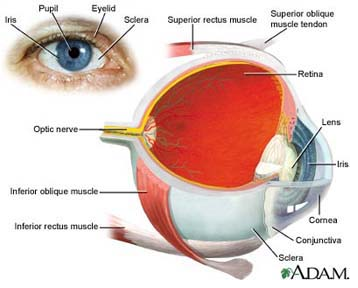
Eyelids
The eyelids act as a preventative covering for the eyeball while helping to keep its surface lubricated. Eyelashes help trap debris and prevent unwanted materials from entering the eye, and the lid themselves block excess light and foreign objects. The eyelids distribute the tear film evenly during blinking, and tiny glands on the edges of the eyelids produce oil which slows evaporation of the tear film and helps lubricate the eye's surface.
The eyelids are composed of several layers. The outermost layer is the skin, followed by a layer of muscle and more supportive tissue and finally by the innermost conjunctiva. The eylid muscles help open and close the eyelids while giving them tone and shape. The conjunctiva on the inside of the eyelids is continuous with the conjunctiva on the surface of the eyeball.
The eyelids act as a preventative covering for the eyeball while helping to keep its surface lubricated. Eyelashes help trap debris and prevent unwanted materials from entering the eye, and the lid themselves block excess light and foreign objects. The eyelids distribute the tear film evenly during blinking, and tiny glands on the edges of the eyelids produce oil which slows evaporation of the tear film and helps lubricate the eye's surface.
The eyelids are composed of several layers. The outermost layer is the skin, followed by a layer of muscle and more supportive tissue and finally by the innermost conjunctiva. The eylid muscles help open and close the eyelids while giving them tone and shape. The conjunctiva on the inside of the eyelids is continuous with the conjunctiva on the surface of the eyeball.
Conjunctiva
The conjunctiva is a thin, transparent mucous membrane that covers three parts of the eye. It lines the inner surfaces of the upper and lower eyelids. It helps form a barrier inside the eylids that separates the front half of the eyeball from the back half (this space is called the fonix). Finally, the conjunctiva becomes even thinner and continues over the front surface of the eyeball up to the edge of the cornea known as the limbus. Generally, the conjunctiva makes blinking and eye movements comfortable.
Sclera
The sclera is the tough, white outer layer of the eyeball. It begins at the edge of the cornea and surrounds the eyeball until it reaches the optic nerve at the back of the eye. The sclera is made of tightly woven interlocking fibers which protect the eyeball from injury and help it to hold its spherical shape. The six muscles at various points on the eyeball are attached to the sclera, and enable the eyeball to move in the desired direction.
The conjunctiva is a thin, transparent mucous membrane that covers three parts of the eye. It lines the inner surfaces of the upper and lower eyelids. It helps form a barrier inside the eylids that separates the front half of the eyeball from the back half (this space is called the fonix). Finally, the conjunctiva becomes even thinner and continues over the front surface of the eyeball up to the edge of the cornea known as the limbus. Generally, the conjunctiva makes blinking and eye movements comfortable.
Sclera
The sclera is the tough, white outer layer of the eyeball. It begins at the edge of the cornea and surrounds the eyeball until it reaches the optic nerve at the back of the eye. The sclera is made of tightly woven interlocking fibers which protect the eyeball from injury and help it to hold its spherical shape. The six muscles at various points on the eyeball are attached to the sclera, and enable the eyeball to move in the desired direction.
Cornea
The cornea is the clear, round, central window in the front of the eyeball which light travels through to enter the eye. It is made up of five transparent layers of tissue, and measures about 12 millimeters in diameter. The purpose of the cornea include protecting the eye (the cornea is very sensitive to pain when it is touched or scratched), allowing light to enter through the eye, and bending and refracting light so that images can focus on the retina and travel to the brain, which allows us to see. Alterations in the normal, curved shape of the cornea can cause astigmatism, nearsightedness and farsightedness.
The cornea is the clear, round, central window in the front of the eyeball which light travels through to enter the eye. It is made up of five transparent layers of tissue, and measures about 12 millimeters in diameter. The purpose of the cornea include protecting the eye (the cornea is very sensitive to pain when it is touched or scratched), allowing light to enter through the eye, and bending and refracting light so that images can focus on the retina and travel to the brain, which allows us to see. Alterations in the normal, curved shape of the cornea can cause astigmatism, nearsightedness and farsightedness.
Iris
The iris is the colored, circular part of the eye that forms the pupil in its center. Irises range in color from blue to green to brown, depending on how much melanin (pigment) they contain. The iris itself is made of muscles and tissues that adjust the size of the pupil so that the appropriate amount of light can travel through to form an image on the retina.
Pupil
The pupil is not an actual physical structure; rather, it is defined as the dark appearing round space in the middle of the iris. The darker the ambient conditions are, the larger the pupil will get to let in more light (this is controlled by muscles in the iris).
The iris is the colored, circular part of the eye that forms the pupil in its center. Irises range in color from blue to green to brown, depending on how much melanin (pigment) they contain. The iris itself is made of muscles and tissues that adjust the size of the pupil so that the appropriate amount of light can travel through to form an image on the retina.
Pupil
The pupil is not an actual physical structure; rather, it is defined as the dark appearing round space in the middle of the iris. The darker the ambient conditions are, the larger the pupil will get to let in more light (this is controlled by muscles in the iris).
Lens
The purpose of the lense is to refract, or bend, light so that an image can form on the retina for the brain to see. The cornea performs about 70% of the necessary bending of light rays, while the lens performs the other 30%. The lense is shaped like a lentil and is located behind the iris, where is is suspended in its own clear capsular bag by fibers called zonules. The lense is made of proteins that form a crystal-like structure, resulting in a clear lens that allows light to pass through it. As a person ages, the proteins in the lens continue to grow, which makes the lense larger, more cloudy, and yellowish brown. This normal aging is called a cataract.
When a person looks at an object up close, the zonules change their tension on the lens, causing it to change its shape slightly. This response is called accommodation. As the lens ages and becomes thicker, it cannot change its shape as easily, and near objects become more difficult to focus on without the help of reading glasses.
The purpose of the lense is to refract, or bend, light so that an image can form on the retina for the brain to see. The cornea performs about 70% of the necessary bending of light rays, while the lens performs the other 30%. The lense is shaped like a lentil and is located behind the iris, where is is suspended in its own clear capsular bag by fibers called zonules. The lense is made of proteins that form a crystal-like structure, resulting in a clear lens that allows light to pass through it. As a person ages, the proteins in the lens continue to grow, which makes the lense larger, more cloudy, and yellowish brown. This normal aging is called a cataract.
When a person looks at an object up close, the zonules change their tension on the lens, causing it to change its shape slightly. This response is called accommodation. As the lens ages and becomes thicker, it cannot change its shape as easily, and near objects become more difficult to focus on without the help of reading glasses.
Retina
The retina is a thin layer of complex nerve tissue that lines the inside back wall of the eyeball. It receives images made of light rays, transfer those images into electrical signals, and send the signals to the brain to be "seen".
Optic Nerve
The optic nerve carries electrical signals from the retina toward the part of the brain known as the visual cortex. Nerve fibers from the retina come together in a bundle to form the optic nerve, which is connected to the brain. The fibers run through the brain, eventually reaching the back area, where the visual cortex is located. Generally, the optic nerve can be thought of as the cable that carries information from the eye to the brain, where that information can be processed into an image that is "seen".
The retina is a thin layer of complex nerve tissue that lines the inside back wall of the eyeball. It receives images made of light rays, transfer those images into electrical signals, and send the signals to the brain to be "seen".
Optic Nerve
The optic nerve carries electrical signals from the retina toward the part of the brain known as the visual cortex. Nerve fibers from the retina come together in a bundle to form the optic nerve, which is connected to the brain. The fibers run through the brain, eventually reaching the back area, where the visual cortex is located. Generally, the optic nerve can be thought of as the cable that carries information from the eye to the brain, where that information can be processed into an image that is "seen".

The eyes are a miracle of engineering! Every part of the eye plays an important role in the overall "seeing" process. Here are the main parts of the eye, and each part's role in providing you with crystal clear vision:
Above:
The Cornea And Iris Close Up
The Cornea And Iris Close Up
See "How Eyes Work" For More Information

Eye Anatomy, And How Eyes Work:
Contact Lenses | Glaucoma | Just For Fun | Eyeglasses | Eye Doctor | Eye Care And Symptoms | Eye Anatomy | Online Eye Tests | Laser Eye Surgery | Laser Eye Surgery Directory: Canada | Laser Eye Surgery Directory: USA | Laser Eye Surgery Reviews | Submit A Review | Contact Us | Privacy Policy | Sitemap
Copyright 2006-2009 Vision Health

